Table of Contents
Transmission Jerk in a Mercedes-Benz GL (9G-Tronic): Case Study
A sudden transmission jerk a sharp bump or lurch during upshifts/downshifts can ruin comfort and hint at deeper calibration, hydraulic, or driveline issues. This case study covers a Mercedes-Benz GL equipped with the 9G-Tronic (725.0) where a repeatable jerk between 70–120 km/h was cured by performing a Standstill Adaptation.
You’ll get a repeatable diagnostic workflow, quick-reference tables, and maintenance advice to prevent the problem from returning.
Case Snapshot
| Item | Detail |
|---|---|
| Vehicle | Mercedes-Benz GL (9G-Tronic 725.0) |
| Complaint | Noticeable gear jerk in Drive (D) at 70–120 km/h, both upshift and downshift |
| History | VGS/TCU previously replaced; no active DTCs on quick test |
| Visual checks | Under-guard removed; no ATF leaks |
| Fix | Standstill Adaptation per XENTRY procedure |
| Result | Post-adaptation road test: no jerk, smooth shifts; master tech validation OK |
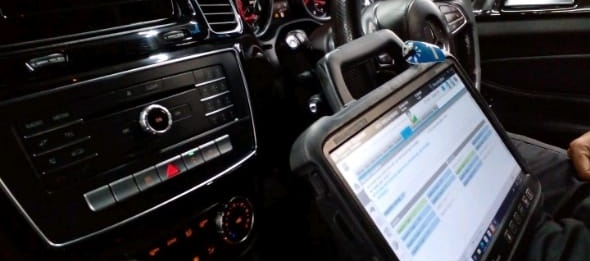
What “Transmission Jerk” Usually Means
A jerk is a momentary torque disturbance felt as a thump or lurch during a shift event. On modern Mercedes transmissions, it’s commonly linked to:
- – Adaptation drift (learned clutch pressures/overlap timing out of spec)
- – ATF condition/temperature outside ideal range during prior learning
- – Mounts/driveline lash amplifying perceived shift harshness
- – Hydraulic control (valve body/solenoids) or software mismatches after repairs
Because this GL had a newer VGS and no DTCs, adaptation quality was the prime suspect.
Symptoms & Likely Causes
| Symptom | Likely Cause(s) | First Checks |
|---|---|---|
| Jerk during steady-throttle upshifts 70–120 km/h | Adaptation out of tolerance, ATF aging/incorrect level | ATF level/quality, road-test live data, check stored adaptations |
| Jerk on gentle decel downshifts | Overlap timing/pressure learn off | Standstill or running adaptation |
| Jerk only when cold | Viscosity effect; marginal previous learns | Warm to spec ATF temp and re-adapt |
| Jerk with light clunk at stops | Engine/trans mounts, driveline lash | Mount inspection; prop shaft/CV play |
| Jerk after VGS or software updates | New control logic needs fresh learn | Guided Standstill/Running Adaptation |
Diagnostic Workflow (Used in This Case)
1. Global Scan (OE-level)
Run a complete short test with XENTRY. In this GL: no DTCs, which pointed away from a hard hydraulic or sensor failure.
2. Visual & Fluid Checks
Lift vehicle, remove under-guard, confirm no ATF leaks. Verify ATF level/condition (correct MB spec).
3. Road Test with Live Data
Reproduce the symptom between 70–120 km/h. Observe shift events, turbine speed, clutch pressure commands. Jerk confirmed on both up and down shifts.
4. Decision: Adaptation First
Given the mild but consistent jerk and clean DTC list, proceed with Standstill Adaptation before deeper mechanical work.

5. Perform Standstill Adaptation (see prerequisites below)
Wheels secured, follow XENTRY prompts: brake fully applied, throttle from 0 to kickdown as instructed. Do not skip prompts or temperature targets.
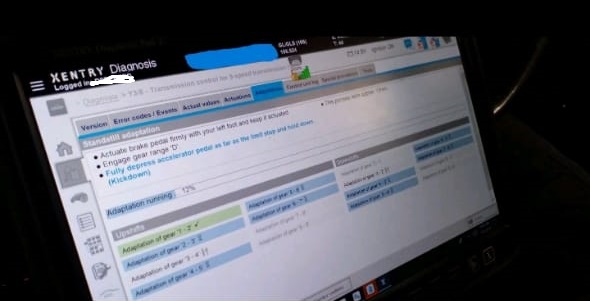
6. Post-Adaptation Road Test
Repeat the same route and speeds. In our case: jerk gone. Master tech verified with an extended loop.
Adaptation Prerequisites & Tips (Must Check)
| Item | Requirement | Why It Matters |
|---|---|---|
| ATF Temperature | Within XENTRY-specified window | Too cold/hot skews pressure learn |
| System Voltage | Stable 12.5–14.5 V (charger connected) | Low voltage interrupts routine |
| Tires/Load | Normal pressures, typical load | Keeps inertia/torque consistent |
| DTC Status | No related powertrain/ABS/ESP DTCs | Stored faults can block or distort learning |
| Pedal Inputs | Follow prompts exactly; brake fully applied | Incorrect inputs abort steps |
| Flat Surface/Secured Wheels | Wheel chocks/rollers if required | Safety + stable readings |
Explore More Mercedes Transmission Issues
For a deeper dive into gearbox problems slipping into Neutral, delayed/harsh shifts, “Not in P” warnings, and hybrid faults visit our hub: Mercedes Transmission Issues – Causes and Fixes. You’ll find grouped case studies, step-by-step diagnostics, symptom–cause–fix tables, and prevention tips to resolve shifting issues quickly and confidently.
Standstill vs Running Adaptation: When to Use
| Mode | Use When | Notes |
|---|---|---|
| Standstill Adaptation | Mild-to-moderate jerk, no DTCs, stable hardware | Fast, safe; ideal after battery work, VGS updates/replacement |
| Running Adaptation | Persistent harshness after standstill, or specific gears misbehave | Performed on the road to refine shift overlaps under load |
In this case, Standstill alone restored smoothness Running was unnecessary.
Transmission Shudder vs Jerk (Don’t Confuse Them)
| Feature | Jerk | Shudder |
|---|---|---|
| Feel | Single bump/thump at shift | Vibration/buzz under light load (e.g., 60–90 km/h) |
| Common Cause | Adaptation/overlap timing | Torque Converter Clutch (TCC) slip, ATF degradation |
| Quick Win | Standstill/Running Adaptation | ATF & filter service, TCC strategy check |
| Next Steps | Mount/valve body checks if persistent | Consider TCC-focused service, software updates |
“Transmission Shudder” Repair: Quick Guide
- 1. ATF & Filter: Replace with correct MB spec; contaminated fluid is the #1 cause.
- 2. Driveability Recheck: Light-throttle cruise where shudder was felt.
- 3. Software & Adaptations: Update VGS if applicable; perform adaptations.
- 4. Driveline: Inspect mounts, prop shaft joints; fix lash that mimics shudder.
- 5. Valve Body/TCC: If unresolved, investigate hydraulic control and TCC application timing.
Maintenance & Service Intervals
Despite “lifetime fluid” marketing, real-world results improve with sensible service.
| Service Item | Suggested Interval* | Notes |
|---|---|---|
| ATF & Filter (9G-Tronic) | 60,000–80,000 km or 4–5 years | Heavy towing/heat → shorten interval |
| Software Check (VGS) | At major service | Apply updates when available |
| Mounts/Driveline Inspection | Annually | Prevents lash-amplified harshness |
*Always confirm per VIN in WIS/ASRA; adjust for severe use.
More information in the next article ; Mercedes 9G Tronic Oil Change : All Information Here
Results in This Case
- – Standstill Adaptation completed successfully (all prompts followed).
- – 25 km+ verification drive: no jerk, crisp up/down shifts.
- – Final inspection showed stable temps, no leaks, and clean fault memory.
- – Master technician sign-off and vehicle returned to customer.
FAQs: Transmission Jerk
Q1. Is it safe to keep driving with a mild jerk?
It’s not immediately dangerous, but it can accelerate clutch wear and mask underlying issues. Diagnose early.
Q2. Will adaptation alone always fix a jerk?
No. Adaptation helps when learned values are off. If ATF is contaminated, mounts are torn, or the valve body is sticking, you’ll need additional repairs.
Q3. Do I need Running Adaptation after Standstill?
Only if symptoms persist. Many cases (including this one) resolve with Standstill alone.
Q4. We replaced the VGS and still have a jerk why?
Fresh controllers typically require re-learning. Perform adaptations with correct ATF temp and stable voltage.
Q5. Can wrong ATF cause harsh shifts or shudder?
Yes. Using incorrect spec or aged fluid disrupts clutch fill times and TCC behavior. Always use the correct MB spec and fill procedure.
Q6. How do motor mounts affect shift feel?
Collapsed mounts amplify perceived harshness by letting the drivetrain move. Inspect mounts before deep transmission work.
Q7. How often should I service a 9G-Tronic?
A practical target is 60–80k km for ATF/filter under normal use; sooner with heavy towing, high heat, or city duty.
Takeaway
On this Mercedes GL, a persistent 70–120 km/h jerk disappeared after a proper XENTRY Standstill Adaptation no parts needed. Start with fluid checks, confirm no DTCs, meet all adaptation prerequisites, and validate with a controlled road test. If harshness remains, move to Running Adaptation, inspect mounts, and only then consider hydraulic/mechanical paths.
Note: Procedures, specs, and temperatures can vary by VIN. Always follow Mercedes-Benz WIS/ASRA and safety practices during testing and adaptations.
Author
Written by: Mercedes Expert
Automotive Technical Trainer & Mercedes-Benz Diagnostic Specialist
With years of hands-on experience repairing and diagnosing Mercedes-Benz vehicles, specializes in case-study-based troubleshooting guides that blend workshop accuracy with educational clarity.
Last Updated: September 2025
— Salim, Mercedes Expert
Independent specialist in Mercedes-Benz diagnostics, CAN Bus analysis, troubleshooting case studies, and EV systems.

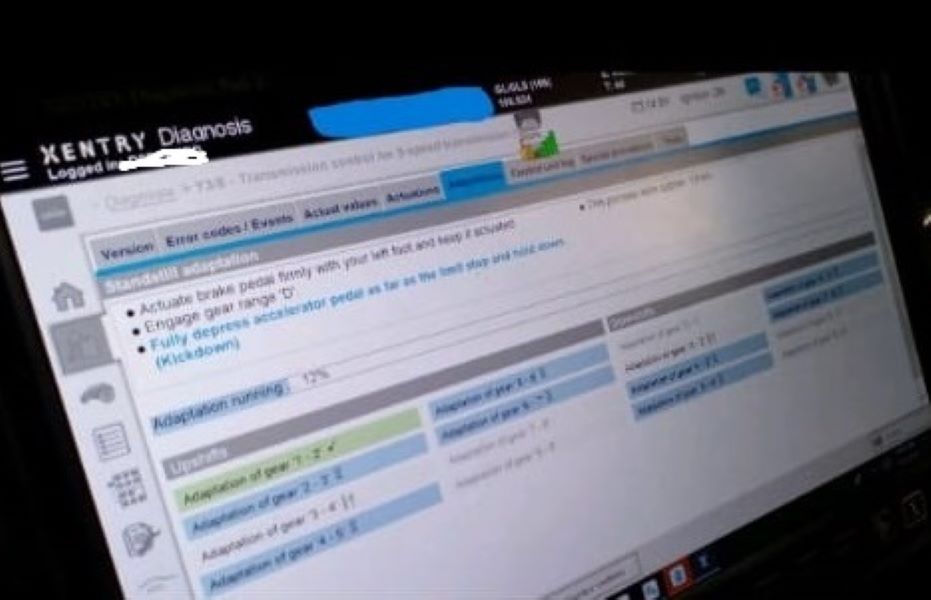


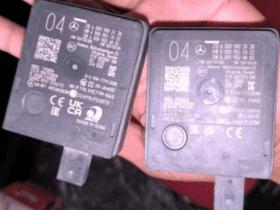
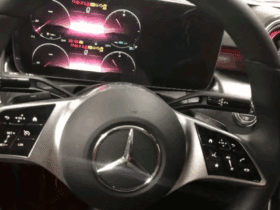
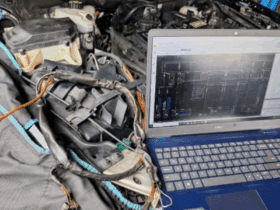
Leave a Reply